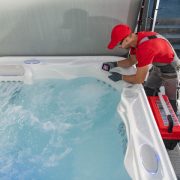
Salt vs. Mineral Bliss: Decoding Spa Water Options for Ultimate Relaxation
Dipping into a spa, you want to be enveloped in waters that not only soothe muscles but also calm the soul. Water quality plays an integral role in this, and the type of spa system you choose – be it salt-based or mineral-based – can make a world of difference. Both have their loyalists and detractors. Here, we’ll dive into these two popular spa treatment options, so you can choose what’s best for your slice of paradise.
1. Saltwater Spa Systems:
Using salt cells that convert salt to chlorine, these systems maintain clean and sanitized spa waters.
Descriptive Use:
- Salt is added directly to the spa water.
- A saltwater generator converts the salt into chlorine, which disinfects the water.
Pros:
- Gentle on Skin: Saltwater feels soft, is less irritating to the skin, and is often lauded for its therapeutic properties.
- Low Maintenance: Once set up, saltwater systems require minimal intervention.
- Cost-Effective: After the initial investment, ongoing costs are typically lower than traditional chlorine systems.
Cons:
- Start-Up Cost: The initial investment for the generator can be higher.
- Electrolytic Cell Maintenance: Salt cells require periodic cleaning to remove calcium build-up.
- Corrosion: Salt can be corrosive, potentially affecting certain spa components over time.
2. Mineral Spa Systems:
Using a blend of minerals (like zinc and copper), these systems reduce the need for chlorine while providing a natural spa experience.
Descriptive Use:
- Mineral cartridges are introduced into the spa’s existing filtration system.
- As water flows over the cartridge, minerals dissolve and continuously sanitize the water.
Pros:
- Reduced Chlorine Usage: Mineral systems sanitize effectively with significantly less chlorine, making water less abrasive.
- Skin-Friendly: Many users report softer skin after using mineral spas.
- Natural Approach: Provides a more eco-friendly and natural-feeling water treatment.
Cons:
- Requires Some Chlorine: Most mineral systems need a minimal amount of chlorine to work effectively.
- Cartridge Replacement: Mineral cartridges need to be replaced periodically, leading to recurring costs.
- Limited Algae Control: Algae blooms might require additional treatments in mineral spas.
Conclusion:
Whether you lean towards the silky embrace of saltwater or the gentle caress of mineral waters, both options offer a refreshing departure from the harshness of traditional chlorine systems. Your choice will boil down to personal preference, budget, and how hands-on you wish to be with maintenance. Whichever path you choose, the result is the same – a blissful spa experience that rejuvenates the body and mind. Dive in and let relaxation take over!


